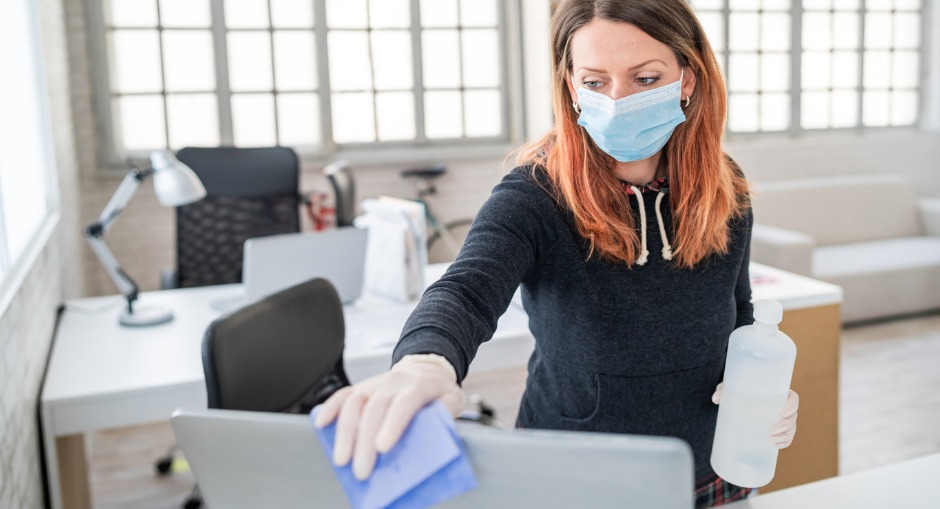
COVID-19 has affected almost every facet of our lives, including the way we work. There are now risks in going to work in traditionally safe environments like the office. One worker infected with COVID-19 can spread it to dozens of colleagues without even realising it. But life and work must go on so organisations are adapting to reduce the risk to staff.
Open-Plan Offices
Offices with dozens of workers in a shared space can be a recipe for disaster with COVID-19. People spend long periods of time in close proximity to each other in an indoor space with plenty of high touch surfaces.
Over the years, desk sizes have shrunk to fit in more workstations. Some businesses have turned the desks in to face each other, so staff can work in teams. Small desks and facing colleagues are risks for transmitting COVID-19, the common cold and the flu.
Some modifications to open-plan offices are to move desks apart to give everyone 1.5 metres of space around them, even placing tape on the carpet as a visual reminder to social distance. Organisations have also turned desks to face the same direction.
Other workplaces have reduced by half the number of workers who can come into the office to make it possible for everyone to social distance.
Large Floors of Staff
High-rise buildings have had the additional difficulty of limiting the number of workers in the lift. Staggered start and finish work times have been used to spread out the arrival and leaving of staff so there are fewer people waiting for the lift. Buildings have imposed limits on the number of people who use the lift at once, so there’s just one person in each corner.
Some organisations have changed the flow of traffic around the office, so workers walk around the office in one direction and don’t pass each other face to face in tight corridors.
Increased Cleaning
We’ve always known our workstations can be a health hazard. Now touching your contaminated keyboard can infect you with a deadly virus. We can clean potential infected hard surfaces with disinfectant products. But high-risk touchpoints like door handles, the kitchen cupboard and lift buttons all need regular cleaning throughout the day, not just once a day when you have many people touching these surfaces.
Hot Desking
Over the years, companies have looked closely at the cost of office space. As the company grew, hot desking became popular to reduce the need for more workstations. Rather than have a set desk for every worker, particularly those who share a job, multiple workers use the same workstation at different times during the week to keep the cost of office space to a minimum. But the pandemic has put hot-desking under the spotlight as risky.
Sitting in the same chair, using a shared desk, keyboard and phone are all surfaces for potential transmission. Some organisations have encouraged staff to use disinfectant wipes to clean surfaces between each staff member. Other organisations have the same staff member sitting at a workstation for one or two weeks before the next team arrives, so there’s always a weekend and thorough cleaning in between two people sharing a space.
Work From Home
Some organisations like Facebook and Twitter announced early in the pandemic they would allow employees to work from home permanently. Few organisations have made promises as permanent, but many expect to see a far greater percentage of employees staying home to work at least part-time well after the risk of the pandemic has passed. But many questioned if we are swapping one health risk for another.
Organisational Liability
Organisations have a duty of care to reduce the risk of transmission of COVID-19 by ensuring good hygiene practices are in place and workers can socially distance properly. Workers who contract COVID-19 at work may be eligible for workers’ compensation and claim for their illness.
Organisations have had to balance the health of employees while maintaining business operations. It’s not an easy juggle and many are questioning if the pandemic will change the way we work now and well into the future?
Ergonomic Equipment in the Home
Organisations have a duty of care to ensure staff are safe wherever they’re working. Some staff have questioned whether they should have access to the same high standard of equipment at home and work, particularly if they’re spending equal or more time working from home in the office. Buying every staff member ergonomic equipment for home and the office is a dilemma for some organisations and cost prohibitive for others.
Some staff don’t have a dedicated space to work at home so they use the kitchen table or even the lounge. Experts have predicted that we’ll see an explosion of workers’ compensation claims from staff being injured while working from home in less than ideal conditions.
If you’re looking for ergonomic equipment to assist with working from home, call Ergolink on (08) 9240 7066 or contact us online.